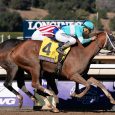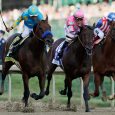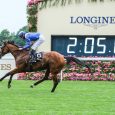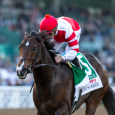By Ray Wallin
Recently a reader asked if I only look at early speed horses when I figure the pace of a race. There are endless books and articles dedicated to playing early speed, but very few that talk about how and when to play closers.
While assessing the impact of early speed is a huge factor when handicapping a race, many novice handicappers overlook the closer. Folks that make their living playing the races know when it is the right time to go with the horse with the big late run.
I am not talking a presser, or horse that likes to sit within two lengths of the lead, or even a stalker who sits between three and five lengths off the lead. I am talking about the two least frequently used designations I assign pace horses, the closer and the deep closer.
When I was learning to handicap from my Uncle Dutch at Monmouth Park, he impressed upon me that like early speed horses, closers are not all created equal. Just as there are horses that need the lead, there are horses that need to set up that late run.
In my analysis, a closer is a horse that comes from between about five and seven lengths off the lead. A deep closer is anything more than that, like Breeders’ Cup Marathon and Brooklyn Handicap winner, Calidoscopio.
If you look at any track, surface and distance, you will find that it is most often horses with the E, E/P, or P running styles (early speed, early/presser, presser) that win most of the races. In Quirin running styles the balance of the stalkers and closers are lumped into the “S” category, which typically has the lowest winning percentage or any running style.
Why don’t closers win more races?
Closers need the “Perfect Storm.” A lot more needs to go right for a closer to win a race than a horse that is on or near the pace. If a race has a couple of frontrunners and one has a troubled trip and fails to influence the pace, another early speed horse can still win.
Hot, contested early pace
An early speed horse can be a strong early speed horse, a one-dimensional front runner, or a habitual quitter. Your early speed winners come from the first two, strong early speed and one-dimensional front runners. Strong early speed horses can duel and outlast the other speed horses in a field. One-dimensional front runners don’t like any pressure on the frontend and win when they can dictate the pace on their own terms. Habitual quitters are the “pop and stop” runners that often get out to a huge early lead early only to falter with no real pace pressure.
Not only do closers need there to be a contested early pace, but the pace also typically needs to be faster than the pace setters are used to running. The early speed needs to expend more energy than normal early, so they are slower later. But if the pace is contested slow, it sets up better for a horse from off the pace who was coasting along closer to the lead.
Ability to overcome the track bias
For every handicapper there is in the world there is a differing opinion on the value of a track bias. Track conditions can fluctuate day-to-day depending on the weather when you look at the entire duration of the meet.
As I am typing this, I have a 6-furlong race at Pimlico on my desk. The Brisnet Track Bias Stats show early speed horses winning 49% of races at this distance, with another 19% of winners being E/P types, 19% of the winners being P or pressers, and only 13% of the winners coming from S or sustained pace runners.
It takes a closer with more ability than others in the field to overcome the track bias.
Not just any closer
In my days spent on the grandstand apron at Monmouth Park there was a guy who would always bet and root for the closers in a race. We called him Closer Carl. He had the infamous “lone closer” angle. He would load up on any horse that was the lone closer in a race full of speed horses. His ideal play was a closer with all E or E/P style runners.
When he had a live runner, he would be calm when the race started, and his horse was running in dead last. “That’s right where he ought to be,” he would quip. As the race wore on his anxiety level would grow. Sometimes his horse would swing wide and storm down the center of the track, but generally he would watch his pick take the field in a last-to-last fashion, never making up any real grand.
Was Closer Carl dead wrong with his thinking?
Not really. There is something to be said for a lone closer in a field of speedy horses. However, you have to look at how that horse compares in form and class, not just running style. Closer Carl would back a $7,500 claiming horse running against upper level claiming or allowance horses without batting an eye. Not only did this closer need to overcome a speed favoring track at Monmouth Park, but it also needed to overcome a multiple level class disadvantage.
You can’t take a closer at “pace” value. You need to assess them the same way you assess the form, class, and back-ability as every speed horse in the field.
As pace handicappers, we focus on the early speed horses. They are going to dictate whether the pace is fast or slow, weak or strong. Most tracks tend to favor early speed or horses that run close to the pace. But given the right conditions this obstacle can be overcome. Don’t be afraid to back a closer or deep closer if the conditions are right, and the pace suits them.




